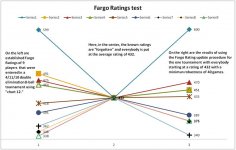@justinhays: Respectfully, if your hypothetical person really played that way he deserves a poor rating. After all, he played 20 games and never won. Pool is about winning not about leaving the fewest balls on the table when you lose.
If a person is constantly running up to the 8 but not getting out they have a big problem and should be working on it.
@Neil: Most handicapping systems weight each person's better scores more than average. Since better players are more consistent than weaker players, i.e., their best and worst performances tend to be much closer to their average performance, the better player usually has an advantage over a weaker player in fairly handicapped matches.
@Mike: Thanks for doing this. As usual you're doing great work. Hope you succeed at Fargo Billiards beyond your wildest dreams.
If a person is constantly running up to the 8 but not getting out they have a big problem and should be working on it.
@Neil: Most handicapping systems weight each person's better scores more than average. Since better players are more consistent than weaker players, i.e., their best and worst performances tend to be much closer to their average performance, the better player usually has an advantage over a weaker player in fairly handicapped matches.
@Mike: Thanks for doing this. As usual you're doing great work. Hope you succeed at Fargo Billiards beyond your wildest dreams.
